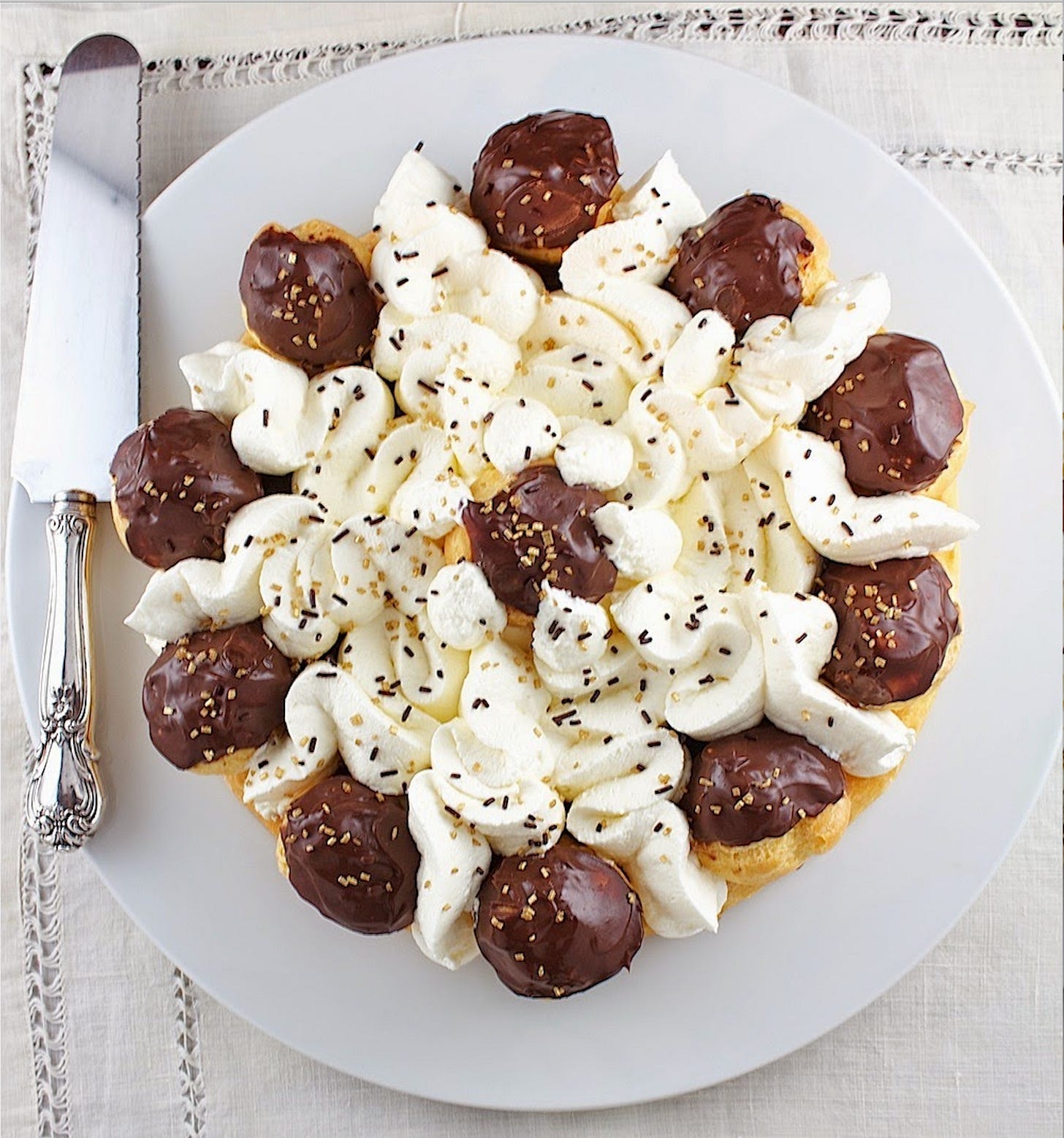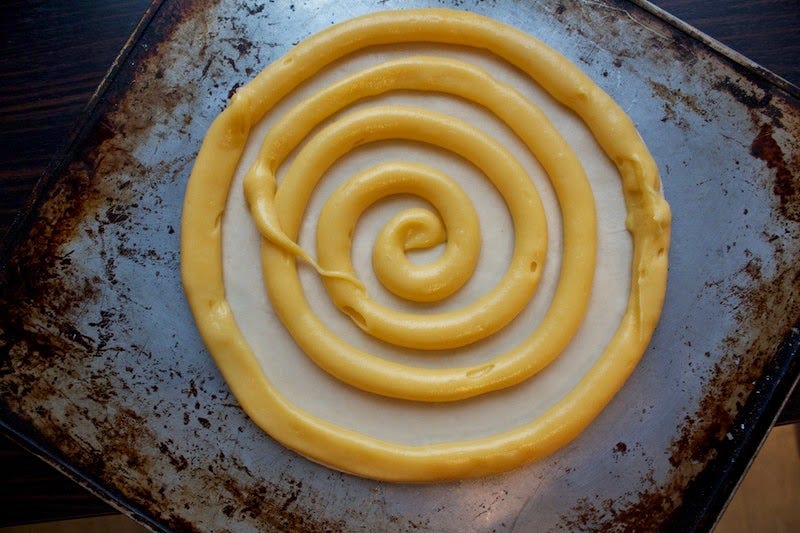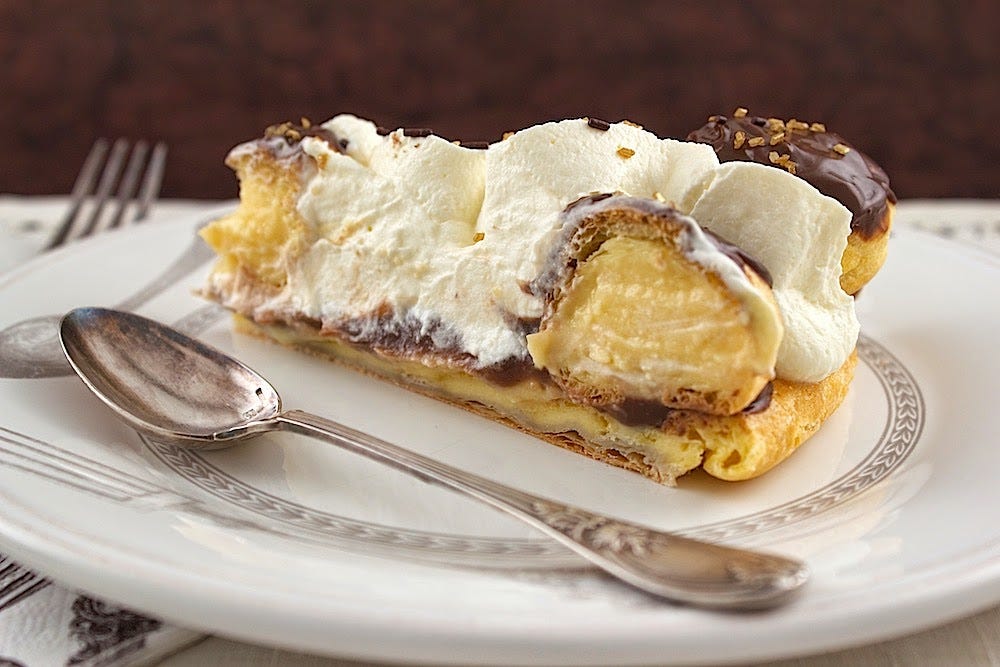No party is any fun unless seasoned with folly. - Desiderius Erasmus
The Saint-Honoré is one of those pretty, showy desserts one finds in a French pastry shop, a pâtisserie, rather than a boulangerie, filled with more humble, homey treats; it’s not a dessert the French, on the average, make at home or eat every day. It’s a special treat for a special meal. Purchased at a pastry shop.
But with a little patience and a little time, it isn’t really complicated to make. And for that special occasion it is definitely worth the effort.
The Saint-Honoré has an interesting evolution, from a simple, rather rustic cream-filled brioche to the elegant pâtisserie it is today. Auguste Julien, young chef in the Parisian pastry shop La Maison Chiboust, created a riff on a traditional cake from Bordeaux, the flan suisse, in 1847. Except for the mention of le flan suisse and le flan à la suisse, listed each time as a “grosse pièce” - a large cake - in the 1815 Le pâtissier royal parisien ou Traité élémentaire et pratique de la pâtisserie ancienne et moderne by our famous friend Marie-Antoine (Antonin) Carême - as elements of his suggested dinner menus, with no accompanying recipe - there is almost no trace of what a flan suisse is anywhere, but it seems to have been a tart-like pastry or cake with a brioche base baked with a cream filling.
Julien seems to have simply turned the original into something rather more sophisticated and elegant with the addition of an edging of pâte à choux, creating a light raised rim, and, once baked, a ring of baked choux puffs are placed atop this edging, draped in caramel. Pastry chef and “French pastry correspondent” Louis Bailleux, in his instructional tome Le pâtissier moderne ou Traité élémentaire et pratique de la pâtisserie française au 19e siècle of 1856, which might very well be one of the first appearances of this new pastry in a cookbook, giving us an indication of what chef Julien created, places glacé fruits - candied fruits - between the choux. Finally, the center of the cake is filled with a crème à la bordelaise, a vanilla pastry cream lightened with a Chantilly or whipped cream, possibly the filling for the flan suisse which itself was à la bordelaise, a speciality of Bordeaux.
Shortly after, the young chef Julien updated the filling to a crème Chiboust, lightening the pastry cream with an egg-white-and-sugar Italian meringue instead of simple whipped cream, named after the Maison Chiboust for whom he worked.
In 1863, Auguste Julien decided to leave the famed Maison Chiboust to open his own bakery, taking, of course, his creation with him. Realizing that the brioche base was less than ideal for a cream tart, the brioche quickly becoming soggy, Julien improved on his recipe by replacing the traditional base with a circle of either pâte brisée, shortcrust pastry, or pâte feuilletée, puff pastry. He filled the little choux with pastry cream, topping each with caramel or chocolate ganache. He finally finished his confection with fancy flourishes of whipped cream or crème Chiboust. Maybe even then using a Saint-Honoré piping tip or nozzle, giving the thick cream its familiar form.
This elegant creation was dubbed the Saint-Honoré, not after Saint Honoré, 8th Bishop of Amiens, as many believe, but rather for the street on which the Maison Chiboust stood, la rue Saint-Honoré. But it is quite the coincidence that Saint Honoré is the patron saint of bakers, so many believe the legend that the cake is named after this holy gentleman, and in its own way, the pastry with the beautiful, fanciful name does pay homage to Saint Honoré.
Vanilla-Rum & Chocolate-Chestnut Saint-Honoré
A ring of pastry cream-filled choux puffs sits atop a base of puff pastry or a simple shortcrust pastry, pâte brisée, each choux coated in either caramel or chocolate ganache, the center of the ring of choux is filled with more pastry cream and topped with a simple, lightly sweetened whipped cream or a more complex crème chiboust, a pastry cream lightened with Italian meringue. It takes time to create and assemble, and although it seems complicated, taken step-by-step it is rather simple and quite fun to make. And it is so very much worth the effort. I simplified the making of the dessert by using a mascarpone whipped cream rather than the crème chiboust. I add a splash of amber rum to the traditional vanilla pastry cream and add a layer of chocolate ganache blended with a bit of sweetened chestnut cream.
Puff Pastry for one 8- or 8 1/2-inch (about 22 cm) very thin (less than but no more than 1/8-inch/ 2-3 mm thick) round, store-bought all-butter puff pastry is fine
1 to 2 tablespoons granulated white sugar
Vanilla Rum Pastry Cream (half batch)
2 tablespoons cornstarch
1 cup (250 ml) whole milk
6 tablespoons (100 grams) sugar
1 large egg
2 large egg yolks
2 tablespoons (30 grams) unsalted butter
1 teaspoon vanilla extract or half a vanilla bean, split lengthwise, seeds scraped
1 tablespoon rum
Chocolate Ganache
3 ½ ounces (100 grams) dark semi- or bittersweet chocolate, 64% or 70% cocoa
½ cup (125 ml) heavy cream
3 to 4 tablespoons crème de marrons – sweetened vanilla chestnut cream, optional but excellent
Choux Pastry
1 cup (250 ml) water
8 tablespoons (115 grams) unsalted butter
¼ teaspoon salt
1 cup (140 grams) flour
4 eggs
Cream Filling
1 cup (250 ml) heavy whipping cream, well chilled
An 8 ounce (250 gram) container mascarpone cheese, well chilled
Powdered sugar, about 3 tablespoons or more to taste
Vanilla Rum Pastry Cream:
Dissolve the cornstarch in ¼ cup (65 ml) milk; whisk until smooth.
Combine the remaining milk with the sugar in a saucepan. Bring to a boil and immediately remove from heat.
If using a half vanilla bean/pod, split the pod down the center and scrape out the seeds. Add both the pod and the seeds to the milk in the pot. Remove the pod once the pastry cream is made and before pouring it into a bowl to chill in the refrigerator.
Beat the whole egg, then the yolks into the cornstarch mixture. Pour ⅓ of the boiling hot milk into the egg mixture in a slow stream, whisking constantly so that the eggs do not begin to cook.
Add the rest of the hot milk to the egg mixture then return all of it back into the casserole and return to the heat. Continue whisking (this is important – you do not want the eggs to solidify/cook) until the cream thickens and comes just to a boil.
Remove from heat and beat in the butter, vanilla, and rum.
Pour the pastry cream into a heatproof pyrex or stainless steel bowl. Press plastic wrap firmly against the surface. Chill immediately and until ready to use.
Chocolate Ganache and Filling:
Coarsely chop the chocolate and place in a heatproof bowl.
Bring ½ cup (125 ml) heavy cream just to a boil and pour over the chopped chocolate. Allow to sit for about a minute, then stir until all of the chocolate is melted and the ganache is smooth.
Allow to cool to room temperature, stirring occasionally, and then reserve in the refrigerator. The ganache will firm as it cools.
Stir about 2 teaspoons of the cooled and thickened ganache into 3 or 4 tablespoons of the chestnut cream. Taste, adding more ganache until desired flavor balance and consistency. Chill until ready to assemble the Saint-Honoré.
Choux and Base of the Saint-Honoré:
Preheat the oven to 400° F (200° C).
Roll out the puff pastry to a 8- or 8 ½ - inch (about 22 cm) circle and to a thickness of no more than ⅛ - inch/ 2-3 mm. Place on a lightly buttered baking sheet.
Prepare the choux dough (see step-by-step photos here): in a large saucepan over medium heat, heat the water, butter and salt until butter melts and the mixture comes to a boil.
Remove from the heat and add the flour all at once. With a wooden spoon, stir vigorously until the mixture forms a ball and pulls away from the sides of the pot.
Scrape the dough into a large heat-proof mixing bowl and, stirring, allow to cool for a minute or two.
Add the eggs, one at a time, beating well after each addition, until the mixture is smooth and creamy.
When the choux dough has cooled to room temperature, place no more than ½ of the dough in a pastry bag with a round tip opening of about ½ to ¾ inch. Pipe a ring of choux dough around the edge of the puff pastry circle then pipe a spiral of dough in the center. Dust the whole with a tablespoon or so of granulated sugar. Bake in the preheated oven for 25 minutes or until the choux dough is puffed and golden and the bottom of the circle is golden as well. Remove from the oven and cool on a rack.
Reduce the oven temperature to 375° F (190° C). Grease a large cookie sheet or line it with oven-safe parchment paper.
Using a teaspoon, scoop up 11 small mounds (about 1-inch diameter) of the dough and carefully push the dough off onto the prepared cookie sheet. They will rise and almost double in size, so leave a bit of space between puffs.
Bake for 35 minutes until risen and golden. Working very quickly, open the oven and, with a sharp knife, make a small slit in the side of each puff to allow steam to escape then bake for about 5 more minutes until golden brown. The puffs will be filled with pastry cream, so it’s better to slightly (slightly) overbake than underbake.
Remove the sheet from the oven, gently remove the choux from the hot baking sheet onto a rack and allow to cool completely.
Once the pastry cream and the choux are cooled, pierce a small hole in the bottom or side of 11 puffs. Fit a pastry bag with a small plain tip, fill the bag with pastry cream, gently nuzzle the tip into one choux after the next and fill.
Dip the top of each filled choux in the remaining chocolate ganache, touching up with a knife or palette knife until the top half of each choux is lightly coated in ganache and it is smooth with no holes apparent. Place back on the tray or plate and refrigerate until ready to assemble the Saint-Honoré.
Assemble the Saint-Honoré:
Pipe and spread a layer of the remaining Vanilla Rum Pastry Cream evenly over the surface of the puff pastry base, coming up to but not covering the choux ring around the edge.
Spread the chocolate chestnut cream on top of this layer of pastry cream.
Dab a bit of chocolate ganache on the bottom of 10 of the filled and ganache-topped choux and arrange them around the border of the base, spacing them evenly, "gluing" each choux down with the dab of ganache. Chill for a few minutes in the fridge to set the ganache.
Pour the cup of heavy whipping in a chilled medium-sized mixing bowl. Beat on high speed until thickened and peaks hold.
Beat in about half of the mascarpone or a bit more, a couple of tablespoons at a time; the whipped mixture should be smooth and very thick.
Beat in a tablespoon or two of powdered sugar at a time until desired sweetness (it should be only lightly sweetened so as to balance out but not overpower the pastry and chestnut creams.)
Scoop the whipped mascarpone cream into a pastry bag with Saint-Honoré tip. Pipe the cream on top of the creams on the base, filling the space between the ring of choux piping out to fill up the spaces between the choux themselves.
Place the 11th filled and ganache-topped choux in the center.
Decorate as desired and serve.
Thank you for subscribing to Life’s a Feast by Jamie Schler where I share my recipes, mostly French traditional recipes, with their amusing origins and history. I’m so glad that you’re here. You can support my work by sharing the link to my Substack with your friends, family, and your social media followers. If you would like to see my other book projects in the making, read my other essays, and participate in the discussions, please upgrade to a paid subscription.










This looks amazing! My skills are not up to making this but I could sure eat that bad boy 😁😋
Finally caught up w/you….my first day on Substack…a bit confusing-new things to learn👈
Extraordinary recipe ‼️Though I doubt my skills are at this level but the history is fascinating 👏Love to put my face into S-H 😂
Happy days
PanacheUS
Off Twitter -it’s gotten a bit MEAN
Must do a new profile here…where to start❓